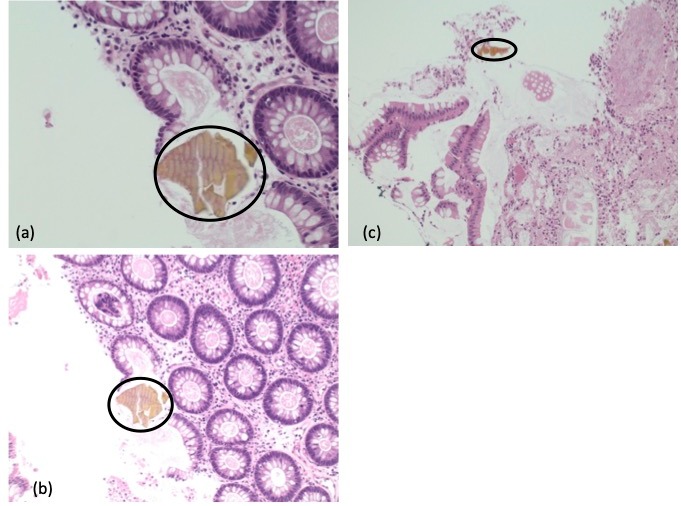Back


Poster Session A - Sunday Afternoon
Category: GI Bleeding
A0314 - Not Your Usual Culprit of Hemorrhagic Shock
Sunday, October 23, 2022
5:00 PM – 7:00 PM ET
Location: Crown Ballroom

Has Audio

Diana Jomaa, MD
Henry Ford Health
Detroit, MI
Presenting Author(s)
Diana Jomaa, MD1, Hamna Fahad, MD2, Sanam Husain, MD3, Radhika Aggarwal, MD3
1Henry Ford Health, Detroit, MI; 2Henry Ford Health System, Detroit, MI; 3Henry Ford Hospital, Detroit, MI
Introduction: Patients with end stage renal disease (ESRD) are at risk of gastrointestinal (GI) bleeding most commonly due to arteriovenous malformation (AVM) or ischemic colitis.They are also at risk for developing hyperphosphatemia commonly treated with phosphate binders such as sevelamer. Sevelamer can crystallize into concretions that lead to GI mucosal injury. Sevelamer induced colitis is rare, but has been described in a subset of these patients.We describe a presentation of severe colitis in a patient with ESRD on sevelamer that manifested as hemorrhagic shock.
Case Description/Methods: This is a 56-year-old African American female with ESRD on hemodialysis.She presented for an elective mitral valve replacement.Anticoagulation was initiated after successful placement of the mechanical valve.Her postoperative course was complicated by shock requiring vasopressors.Her clinical presentation was thought to be secondary to septic shock.Empiric treatment with antibiotics was initiated, but they were discontinued after a negative infectious work up.Her hemoglobin slowly trended down from 10 to 7 mg/dL. She was persistently hypotensive with multiple large bloody bowel movements requiring blood transfusion attributed to ischemic colitis or AVM.Given hemodynamic instability, she underwent a computed tomography angiography which was negative for active bleeding.Nasogastric lavage also showed bilious output.When she stabilized, a colonoscopy was performed that showed a localized area of granular, erythematous, and ulcerated mucosa in the descending colon near the splenic flexure that was friable on contact.Biopsies showed fragments of resin material morphologically consistent with sevelamer crystals admixed with acute and chronic inflammation. Sevelamer was discontinued and anticoagulation was resumed.Subsequently, bleeding stopped and hemoglobin stabilized.
Discussion: Sevelamer is a commonly used phosphate binder in patients with ESRD.GI adverse effects of sevelamer are largely under-recognized and under-diagnosed. Sevelamer is dissociated in the stomach, releasing a polymer that binds phosphate within the intestine, producing phosphate crystalline concretions that are excreted in the feces.These concretions can also embed inside eroded or ulcerated GI tract mucosa in patients with ESRD.With the increased use of phosphate binders, it is important to recognize GI side effects including the potential for GI mucosal injury in order to keep this in the differential diagnosis and immediately stop the offending agent.

Disclosures:
Diana Jomaa, MD1, Hamna Fahad, MD2, Sanam Husain, MD3, Radhika Aggarwal, MD3. A0314 - Not Your Usual Culprit of Hemorrhagic Shock, ACG 2022 Annual Scientific Meeting Abstracts. Charlotte, NC: American College of Gastroenterology.
1Henry Ford Health, Detroit, MI; 2Henry Ford Health System, Detroit, MI; 3Henry Ford Hospital, Detroit, MI
Introduction: Patients with end stage renal disease (ESRD) are at risk of gastrointestinal (GI) bleeding most commonly due to arteriovenous malformation (AVM) or ischemic colitis.They are also at risk for developing hyperphosphatemia commonly treated with phosphate binders such as sevelamer. Sevelamer can crystallize into concretions that lead to GI mucosal injury. Sevelamer induced colitis is rare, but has been described in a subset of these patients.We describe a presentation of severe colitis in a patient with ESRD on sevelamer that manifested as hemorrhagic shock.
Case Description/Methods: This is a 56-year-old African American female with ESRD on hemodialysis.She presented for an elective mitral valve replacement.Anticoagulation was initiated after successful placement of the mechanical valve.Her postoperative course was complicated by shock requiring vasopressors.Her clinical presentation was thought to be secondary to septic shock.Empiric treatment with antibiotics was initiated, but they were discontinued after a negative infectious work up.Her hemoglobin slowly trended down from 10 to 7 mg/dL. She was persistently hypotensive with multiple large bloody bowel movements requiring blood transfusion attributed to ischemic colitis or AVM.Given hemodynamic instability, she underwent a computed tomography angiography which was negative for active bleeding.Nasogastric lavage also showed bilious output.When she stabilized, a colonoscopy was performed that showed a localized area of granular, erythematous, and ulcerated mucosa in the descending colon near the splenic flexure that was friable on contact.Biopsies showed fragments of resin material morphologically consistent with sevelamer crystals admixed with acute and chronic inflammation. Sevelamer was discontinued and anticoagulation was resumed.Subsequently, bleeding stopped and hemoglobin stabilized.
Discussion: Sevelamer is a commonly used phosphate binder in patients with ESRD.GI adverse effects of sevelamer are largely under-recognized and under-diagnosed. Sevelamer is dissociated in the stomach, releasing a polymer that binds phosphate within the intestine, producing phosphate crystalline concretions that are excreted in the feces.These concretions can also embed inside eroded or ulcerated GI tract mucosa in patients with ESRD.With the increased use of phosphate binders, it is important to recognize GI side effects including the potential for GI mucosal injury in order to keep this in the differential diagnosis and immediately stop the offending agent.

Figure: Figure 1: Sevelamer crystals are highlighted in figures (a),(b),and (c) with acute inflammation demonstrated in (c).
Disclosures:
Diana Jomaa indicated no relevant financial relationships.
Hamna Fahad indicated no relevant financial relationships.
Sanam Husain indicated no relevant financial relationships.
Radhika Aggarwal indicated no relevant financial relationships.
Diana Jomaa, MD1, Hamna Fahad, MD2, Sanam Husain, MD3, Radhika Aggarwal, MD3. A0314 - Not Your Usual Culprit of Hemorrhagic Shock, ACG 2022 Annual Scientific Meeting Abstracts. Charlotte, NC: American College of Gastroenterology.
